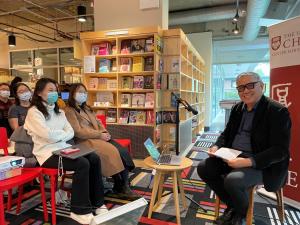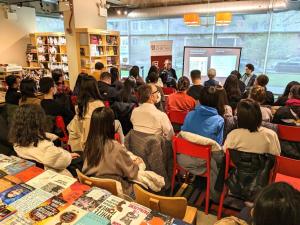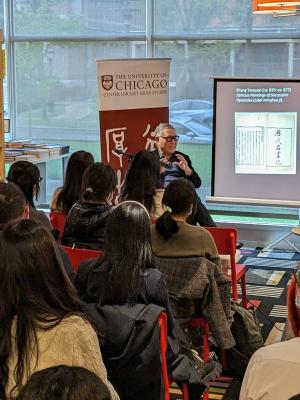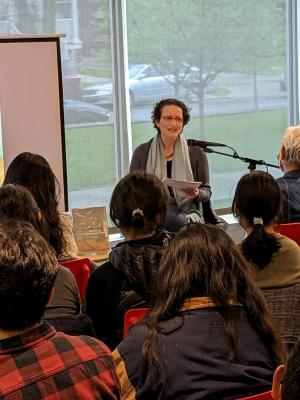Art History's Wu Hung and Claudia Brittenham Discuss Three Publications on Chinese art
Published on May 16, 2023 
On May 1, the Center for East Asian Studies hosted Wu Hung, Harrie A. Vanderstappen Distinguished Service Professor in Chinese Art History at the University of Chicago, one of the foremost scholars in Chinese art history who serves, among other things, as Director of the Center for the Art of East Asia and adjunct curator of the Smart Museum. Professor Wu came to the Seminary Coop Bookstore with Professor Claudia Brittenham in the department of Art History at the University of Chicago to discuss his three recent books: Chinese Art and Dynastic Time (Princeton University Press 2022), Spatial Dunhuang: Experiencing the Mogao Caves (University of Washington Press 2023) and The Full Length Mirror: A Spatial Visual History (University of Chicago Press 2022). Each of these texts exhibits, in Brittenham’s words, Wu’s “capacity to abandon the paradigms we take for granted” and helps to “generate” new questions, while simultaneously “treating the works themselves as discourse.”
 Chinese Art and Dynastic Time, based on six lectures delivered by Professor Wu in 2019, questions the common reliance in Chinese art history on the conception of dynastic time, that is, grouping and examining works based on their originating dynasty. Professor Wu showed examples of this taken-for-granted classification system and gave examples of the kinds of questions his book seeks to answer about this system: namely, is it really that natural? How did this kind of narrative appear? How has this narrative changed over time, and to what extent has the development of the dynastic time system affected the development of Chinese art itself? Through ten different case studies, Wu shows that dynastic time is in fact a carefully constructed narrative.
Chinese Art and Dynastic Time, based on six lectures delivered by Professor Wu in 2019, questions the common reliance in Chinese art history on the conception of dynastic time, that is, grouping and examining works based on their originating dynasty. Professor Wu showed examples of this taken-for-granted classification system and gave examples of the kinds of questions his book seeks to answer about this system: namely, is it really that natural? How did this kind of narrative appear? How has this narrative changed over time, and to what extent has the development of the dynastic time system affected the development of Chinese art itself? Through ten different case studies, Wu shows that dynastic time is in fact a carefully constructed narrative.
In Spatial Dunhuang: Experiencing the Mogao Caves, Professor Wu reimagines scholarship around the Mogao Caves by thinking spatially rather than temporally. The Mogao Caves are a cave complex containing a large collection of Buddhist art from across a wide range of time. Their study is so important in Chinese Art History that it has become its own subfield. While other scholars have mainly focused on trying to process the caves into charts that categorize them based on their (often dynastic) time of origin, Wu tries to think about the experience of entering the caves, trying to use space as a structure before tying in temporality. He divides the book into five chapters focusing on different scales: first on the entire broader region around the caves, then about the cliff and cave complex (“total space”), then focusing on “interior space” within the caves, then seeing “sculptural and pictorial programs” (that is, the way in which the juxtaposed parts of different caves interact) and then looking at the “pictorial space”--space within each painting. This, according to Brittenham, allows him to more fully simulate the “embodied experience of being at the site” and focus on moments of “transformation” rather than arbitrary, extrinsic, dynastic changes.
In The Full Length Mirror: A Global Visual History, Wu traces the global history of the full length mirror, which combined European mirror technology with Asian use of screens, inviting readers to “imagine different kinds of genealogies.” He traces the literary and visual imagination of full length mirrors, including fake mirrors in the Forbidden City, and ties mirrors to photography and the aristocracy in his sections “Medium and Subjectivity” and “Individuality and Subjectivity”. After Wu’s explanation, Brittenham emphasized the book’s incredible scope, not only across three continents but across several media.
After Wu and Brittenham each went over the three works, Wu answered questions from Brittenham and the audience. Wu revealed insights into his process, including that he often works on multiple books at the same time, using the metaphor of burners on a stove, and that he tries to “tell stories” by examining the material itself from different angles rather than imposing another story on the material. He doesn’t plan to shift paradigms, but these new angles emerge as a result of telling specific stories. Wu and Brittenham also discussed the question of new archaeological materials uncovered in Chinese art, which Wu sees as important and worthy of its own subfield, as well as the different ways he writes for American versus Chinese audiences, especially given the much greater popularity of art history with amateurs in China. Audience questions finally wrapped up the conversation by asking about what other works Wu has on his “burner” and how he thinks about the contemporary interest in studying “materiality” in academia at large.
This event was a part of the East Asia by the Book! CEAS Author Talks series, an initiative co-sponsored together with the Seminary Co-op Bookstores, which showcases CEAS faculty, alumni, and special guests who provide author talks and book launches at the Seminary Co-op Bookstore as a way to engage the broader community in conversations regarding key scholarship on East Asia.  For more information on this book talk and the books discussed, click here.
For more information on this book talk and the books discussed, click here.

 THE UNIVERSITY OF CHICAGO
THE UNIVERSITY OF CHICAGO

